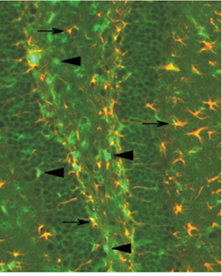
Green- and orange-labeled cells' prominence in the hippocampus is a sign of inflammation and injury in the brain.
A potential treatment for status epilepticus can reduce the inflammation when given after prolonged seizures.
A new type of prophylactic treatment for brain injury following prolonged epileptic seizures has been developed by Emory University School of Medicine investigators.
Status epilepticus, a persistent seizure lasting longer than 30 minutes, is potentially life-threatening and leads to around 55,000 deaths each year in the United States. It can be caused by stroke, brain tumor or infection as well as inadequate control of epilepsy. Physicians or paramedics now treat status epilepticus by administering an anticonvulsant or general anesthesia, which stops the seizures.
Researchers at Emory have been looking for something different: anti-inflammatory compounds that can be administered after acute status epilepticus has ended to reduce damage to the brain. They have discovered a potential lead compound that can reduce mortality when given to mice after drug-induced seizures.
The results were published Monday, February 11 in Proceedings of the National Academy of Sciences Early Edition.
“For adults who experience a period of status epilepticus longer than one hour, more than 30 percent die within four weeks of the event, making this a major medical problem,” says Ray Dingledine, PhD, chair of the Department of Pharmacology at Emory University School of Medicine. “Medications that would reduce the severe consequences of refractory status epilepticus have been elusive. We believe we have an effective route to minimizing the brain injury caused by uncontrolled status epilepticus.”
Dingledine’s laboratory has identified compounds that block the effects of prostaglandin E2, a hormone involved in processes such as fever, childbirth, digestion and blood pressure regulation. Prostaglandin E2 is also involved in the toxic inflammation in the brain arising after status epilepticus.
The first author of the paper is postdoctoral fellow Jianxiong Jiang, PhD, and the medicinal chemist largely responsible for developing the compounds is Thota Ganesh, PhD.
Jiang and colleagues induced status epilepticus in mice with the alkaloid drug pilocarpine, and gave them a compound, TG6-10-1, starting four hours later and again at 21 and 30 hours. TG6-10-1 blocks signals from EP2, one of four receptors for prostaglandin E2.
Among animals that received the EP2 blocker, 90 percent survived after one week, while 60 percent of a control group survived. The scientists also used nest-building behavior and weight loss as gauges of damage to the brain. Four days after status epilepticus, all the animals that received TG6-10-1 displayed normal nest-building, but more than a quarter of living control animals were not able to build nests. In addition, the brains of TG6-10-1-treated mice had reduced levels of inflammatory messenger proteins called cytokines, less brain injury and less breach of the blood-brain-barrier.
Consequences of refractory status epilepticus can lead to brain damage and death, says David Wright, MD, director of emergency neurosciences in the Emory Department of Emergency Medicine.
“We have a limited number of drugs in our tool box to treat status epilepticus,” Wright says. “These are focused at stopping the seizure – but we have nothing that can improve outcomes against the brain damage that often results.”
Dingledine says the first clinical test of an EP2 blocking compound would probably be as an add-on treatment for prolonged status epilepticus, several hours after seizures have ended. It could also be tested in similar situations such as subarachnoid hemorrhage, prolonged febrile seizures or medication-resistant epilepsy, he says.
Dingledine and his colleagues have a patent pending for novel technology related to this research. Under Emory policies, they are eligible to receive a portion of any royalties or fees received by Emory from this technology.
The research was supported by the Epilepsy Foundation, the National Institute of Neurological Disorders and Stroke (U01NS058158, R21NS074169 and N01NS42359) and the CounterACT Program (NIH Director’s Office).
Reference: J. Jiang, Y. Quan, T. Ganesh, W.A. Pouliot, F.E. Dudek and R. Dingledine. Inhibition of the prostaglandin receptor EP2 following status epilepticus reduces delayed mortality and brain inflammation. PNAS Early Edition, online before print (2013).
